Devil's Lake State Park (Wisconsin)
Devil's Lake State Park is a state park located in the Baraboo Range in eastern Sauk County, just south of Baraboo, Wisconsin. It is around thirty-five miles northwest of Madison, and is on the western edge of the last ice-sheet deposited during the Wisconsin glaciation.[2] The state park encompasses 9,217 acres (3,730 ha),[3] making it the largest in Wisconsin.[4] The state park is known for its 500-foot-high (150 m) quartzite bluffs along the 360-acre (150 ha) Devil's Lake, which was created by a glacier depositing terminal moraines that plugged the north and south ends of the gap in the bluffs during the last ice age approximately 12,000 years ago. The sand at the bottom of Devil's Lake is thought to be deposited by glaciers.
| Devil's Lake State Park | |
|---|---|
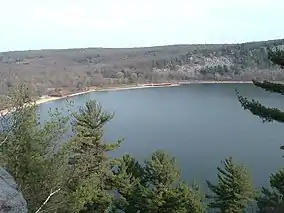 Devil's Lake from the West Bluff | |
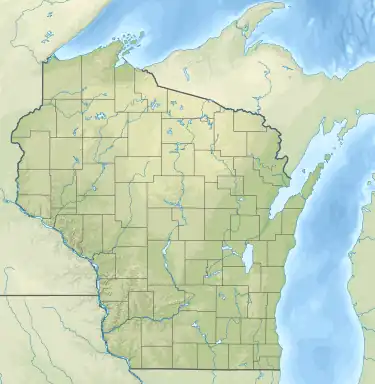 Location of Devil's Lake State Park in Wisconsin  Devil's Lake State Park (Wisconsin) (the United States) | |
| Location | Sauk County, Wisconsin, United States |
| Coordinates | 43°24′53″N 89°42′47″W |
| Area | 9,217 acres (37.30 km2) |
| Elevation | 1,329 ft (405 m)[1] |
| Established | 1911 |
| Governing body | Wisconsin Department of Natural Resources |
There are many quartzite rock formations, such as Balanced Rock and Devil's Doorway, throughout the park. Effigy mounds are also located throughout the park. The park contains approximately eleven miles of the 1,200-mile (1,900 km) Ice Age Trail.[5] Its scenic beauty, along with its proximity to the Wisconsin Dells, has made it one of the most popular of Wisconsin's state parks for both day use and overnight camping; the park receives over three million visitors annually.[6] During the fall, the park's brilliant foliage makes it a popular attraction. Parfrey's Glen, Wisconsin's first state natural area, is managed by the Devil's Lake State Park and located just east of the park.
History
The original inhabitants of the area around the lake date back much further than when the European settlers first discovered the land. There is proof that humans occupied the land between 12,000 to 16,000 years ago, but Ho-Chunk historians speak of people living there longer than 300,000 years ago.[7] The area may have been inhabited originally between 12,000 to 16,000 years ago due to the fact that this was the time the last of the glaciers had receded from the area. Many Native tribes throughout Wisconsin inhabited the lands. They called the lake various different names, such as Tewakakak or Minnewaukan, which translate to spirit lake in various Native American Languages.[7]
The area where the park now stands was first settled by pioneers in the mid-1800s. By the start of the 20th century, the area had become a popular vacation destination for wealthy families from Chicago and Madison. The first hotel was established in 1866, 50 years before the park was founded.[8]
The park was founded in 1911.[9] It was home to five resorts, two of which were perched on the west bluff. Few traces of these structures remain, though footings and foundational structures can be found along the South shore and near Prospect Point on the West Bluff. There were also many private residences in the west and south shores of the lake, only four of which remain.[10] At various times the lakeshore hosted water slides, lodges, ferry boat launches and golf courses. The clubhouse of one course sat on the current location of the Park's nature center. By the 1940s, the hotels were all closed, and the Park was retreating to its former natural self.
From 1934 to 1941, approximately two hundred members of the Civilian Conservation Corps resided in a work camp. These young men built many of the trails, buildings, and benches still in use today.[9]
In 1974, the National Park Service declared the Southern portion of the Baraboo Hills a National Natural Landmark. The Nature Conservancy also designated it as one of the "Last Great Places," one of only 77 such designations in the world.[4]
In 2020, a man was stabbed to death along the Grottos Trail.[11] Several witnesses reported seeing a man running from the scene of the murder, but he remains unidentified. As of 2023, the case remains unsolved.[12]
Features
Geology
Loess covers most of the hills and forms the parent material of a brown silt loam soil. The lake is surrounded by a mixed conifer-deciduous forest and the Baraboo Hills are also home to one of the largest contiguous hardwood forests in the Midwest.[4]
Several moraines are featured in the park, another side effect of glaciation. The North Glacial Moraine is well covered by the north shore developments. The parking lots, concession building and the picnic shelter all sit atop the moraine. This moraine forms the northern border of Devil's Lake.[13] This moraine is approximately 80 feet (24 m) thick.[14] The Southeast Glacial Moraine is located between the East Bluff-South Face and the South Bluff. The Group Camp is located atop the moraine. It is best seen from the Roznos Meadow parking area along State Route 113.[13] The moraine is approximately 130 feet (40 m) thick.[14]
- Hiking up the East Bluff of Devil's Lake Park
 Southeast moraine between the South Bluff and the East Bluff-South Face
Southeast moraine between the South Bluff and the East Bluff-South Face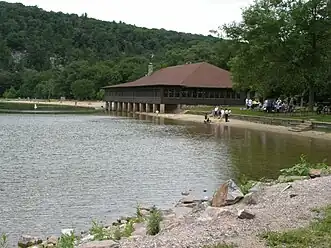 The "Chateau" atop the North Glacial Moraine
The "Chateau" atop the North Glacial Moraine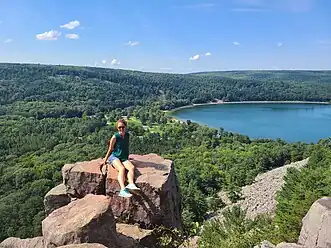 Eastern View of Devil's Lake from above
Eastern View of Devil's Lake from above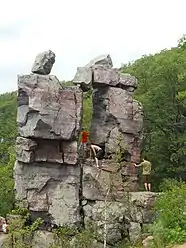 Devil's Doorway rock formation
Devil's Doorway rock formation- View of Devil's Lake from Devil's Doorway
Due to the long geological history of Devil's Lake and the Baraboo Range, the area has been used in geological research for years. The lake itself is rectangular in shape and is a little over a mile long from north to south and a half mile from east to west. It has many cliffs, unique rock formations and a variety of animal and plant species.[15] One of the most notable features of the park is the presence of large talus slopes on three sides of the lake.[16]
Buildings

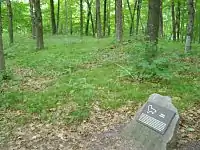
The state park includes many buildings on its land. The exhibits at the park's nature center focus on the geology and natural history of the area. Public nature programs are offered in the summer, as well as evening programs on Saturday nights in the Northern Lights Amphitheater. The nature center also has many historical photographs that come from as far back as the 1800s. They also have many displays of examples of the flora and fauna that can be found throughout the park.[4]
Mounds
The park has several American Indian mounds. Across the parking lot from the nature center are effigy mounds built in stylized animal shapes, such as a lynx and a sparrow. In front of the concession building is a linear mound, one of several geometric mounds in the park. These mounds were used as ancient burial sites by early North Americans. The nature center offers courses on the history of the effigy mounds.[17][18]
Recreational activities
Hiking
There are 29 miles (47 km) of hiking trails in Devil's Lake State Park. There are trails ranging from handicapped-accessible paved trails, to steep, difficult hiking trails, to rigorous, off-trail routes. The highest point is at Prospect Point, on the West Bluff, 500 feet (150 m) above Devil's Lake.[19]
- Balanced Rock Trail (0.4 miles)
- C.C.C. Trail (0.3 miles)
- Devil's Doorway (0.1 miles)
- East Bluff Trail (1.7 miles)
- East Bluff Woods Trail (1.3 miles)
- Grottos Trail (0.7 miles)
- Group Camp Trail (0.5 miles)
- Ice Age National Scenic Trail (All parts - 13.7 miles)
- Johnson Moraine Loop Trail (2.8 miles)
- Parfrey's Glen Trail (0.7 miles)
- Potholes Trail (0.3 miles)
- Roznos Meadow Trail (1.8 miles)
- Sauk Point Trail (4.5 miles)
- Steinke Basin Loop Trail (2.4 miles)
- Tumbled Rocks Trail (1 mile)
- Upland Loop Trail (3.8 miles)
- West Bluff Trail (1.4 miles)
Biking
Devil's Lake State Park has four miles of off-road - the Upland Trail Loop. There are no official paved road-bike trails in the park, although many people enjoy riding several miles on all the paved campground roads.
Camping
There are four popular campgrounds at the park containing 407 campsites all together:
- Northern Lights Campground
- Quartzite Campground
- Ice Age Campground
- Group Campground
Northern Lights Campground features a decent sledding hill.[4]
%252C_1862-1922.jpg.webp)
Rock climbing
_(14775022334).jpg.webp)
The geology of the Baraboo Hills surrounding Devil's Lake makes it one of the premier rock climbing areas in the Midwest, with climbs of varying difficulty. The Baraboo Hills are primarily quartzite, which is solid enough to climb. Most outcroppings in the region, especially in the Driftless Area, are composed of sandstone or limestone, which are too brittle to climb safely.
Devil's Lake has enjoyed a history of rock climbing since early ascents in the 20th century. Climbers such as the Stettner Brothers, and members of the hard-climbing group "DLFA"[20] have frequented the park extensively. Guidebooks cover more than a lifetime's worth of unique "routes" and sub-areas of the park.[21] For climbers, unique names for each major bluff formation is important in finding specific climbs and areas. The climbing style and protection system at Devil's Lake is known for its difficult, glassy rock and traditional fall-protection methods and anchors.[21]
There have been occasional deaths, injuries, and emergency rescues among the rock climbers at Devil's Lake.[22][23]
East Bluff
The "East Bluff" refers to the Eastern outcroppings in the park, and includes many sub-areas for climbers, including "Doorway Mass" which are climbs surrounding the famous Devil's Doorway formation, "Balanced Rock Wall" near the famous Balanced rock, and an area off of the CCC trail known as the "East Ramparts" which is the most popular due to the high concentration of sheer, unbroken cliff faces to climb.[24]
West Bluff
The west side of the park features climbing areas such as "Stettner Rocks", The Cleo Amphitheatre, and the "Lost Face". The Cleo Amphitheatre features the classic climb of a 25 ft freestanding spire known as "Cleopatra's Needle"[21][25]
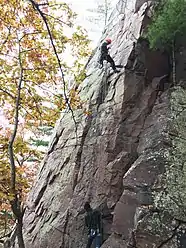 The climb "Cheatah" is a classic line on what is known as Bill's Buttress in the East Bluff
The climb "Cheatah" is a classic line on what is known as Bill's Buttress in the East Bluff Chimney Rock
Chimney Rock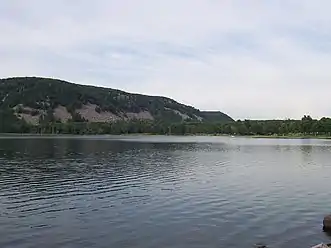 Beach on south end of Devil's Lake
Beach on south end of Devil's Lake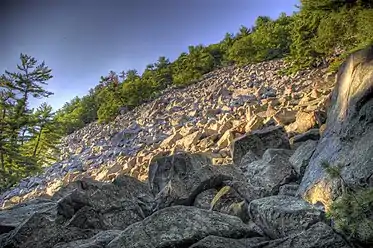 Boulder field on Eastern bluff at Devil's Lake
Boulder field on Eastern bluff at Devil's Lake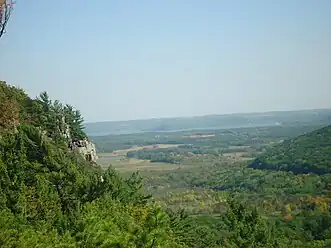 View of Baraboo Hills from top of one of the mountains
View of Baraboo Hills from top of one of the mountains
Wildlife
Wildlife abounds at Devil’s Lake State Park. Among the flora and fauna[26] at Devil’s Lake are:
- 58 species of butterflies, including the rare White Admiral
- 29 species of fish, mostly native, excepting the trout, carp and white bass
- 5 species of salamander, 1 species of toad, and 10 species of frogs
- 4 species of turtles and 10 species of snakes, including the Timber rattlesnake[27]
- 228 bird species have been recorded in the Park, 105 of which have been recorded nesting in the Park
- 4 species of owl - screech owl, great horned owl, barred owl, saw-whet owl
- Up to 40 mammal species have been reported in the Park, including white-tailed deer, black bear, raccoon, skunk, badger, weasels, mink, otter, bobcat, mountain lion, gray and red foxes, coyote, gray wolf, beaver, porcupine, woodchuck, muskrat, voles, opossum, rabbit, shrews, moles, mice, rats and four species of bats
Climate
| ||||||||||||||||||||||||||||||||||||||||||||||||||||||||||||||||||||||||||||||||||||||||||||||||||||||||||||||||||||||||||||
References
- "Devils Lake State Park". Geographic Names Information System. United States Geological Survey. August 29, 1980. Retrieved March 18, 2011.
- Salisbury, Rollin; Wallace Walter Atwood (1897). "Drift Phenomena in the Vicinity of Devil's Lake and Baraboo, Wisconsin". The Journal of Geology. 5 (2): 131–147. Bibcode:1897JG......5..131S. doi:10.1086/607730.
- "Pick a Park – WDNR". Wisconsin Department of Natural Resources. Archived from the original on May 10, 2009. Retrieved January 25, 2009.
- "Regional & Property Analysis: Sauk Prairie Recreation Area". July 2012: 1–67.
{{cite journal}}: Cite journal requires|journal=(help) - "Ice Age Trail: Devil's Lake Segment Hiking Trail, Baraboo, Wisconsin". Hiking Project. Retrieved October 15, 2021.
- [Devil's Lake - What Do I Need to Know?] Devil's Lake State Park Area Visitor's Guide. Accessed 19 Sept 2019.
- "A Brief Human History of Devil's Lake State Park, Baraboo, WI". Devils Lake Climbing Guides. Retrieved May 2, 2022.
- Lange, Kenneth; Berndt, D. Debra (1980). "Devil's Lake State Park: The History of its Establishment". Transactions of the Wisconsin Academy of Sciences, Arts and Letters. 68: 149–166.
- "Devil's Lake State Park: 100 Years of Stories". Wisconsin Department of Natural Resources. Retrieved April 22, 2018.
- "Devil's Lake centennial". Archived from the original on April 2, 2018. Retrieved September 19, 2019.
- https://www.wkow.com/news/devils-lake-homicide-remains-unsolved-after-2-years/article_5f5435fe-4c14-11ed-8488-17be184d1f4c.html
- https://www.nbc15.com/2023/02/07/more-information-sought-2020-homicide-devils-lake-state-park/?outputType=amp
- Devil's Lake State Park, Landmark Nature Trail; Baraboo, Wisconsin, 2008
- Devil's Lake State Park, West Bluff Self-Guide Tour; Baraboo, Wisconsin, 2008
- Trowbridge, Arthur (1917). "The History of Devil's Lake, Wisconsin". The Journal of Geology. 25. 25 (4): 344–372. Bibcode:1917JG.....25..344T. doi:10.1086/622484. S2CID 129772974.
- "Geology | Wisconsin DNR". dnr.wisconsin.gov. Retrieved October 22, 2021.
- Wisconsin Department of Natural Resources (January 5, 2011). "Effigy Mounds of Devil's Lake". Archived from the original on June 6, 2010.
- Wayside exhibits located by each mound
- Map and Trail Guide to Devil's Lake State Park. Baraboo, Wisconsin: 2004.
- Limvere, Darin (May 3, 2013), Watch The D.L.F.A. Online | Vimeo On Demand, retrieved November 2, 2018
- Olof., Swartling, Sven (2008). Climber's guide to Devil's Lake. Mayer, Pete. (3rd ed.). Madison, Wis.: University of Wisconsin Press. ISBN 9780299228545. OCLC 223848284.
{{cite book}}: CS1 maint: multiple names: authors list (link) - Buckley, William Lee, Madeline. "DePaul student 'turned her life around' with climbing but dies in fall at Devil's Lake State Park in Wisconsin". chicagotribune.com. Retrieved October 22, 2021.
{{cite web}}: CS1 maint: multiple names: authors list (link) - Erickson, Doug (July 8, 2007). "Pain and death at Devil's Lake treacherous rock formations and cliffs at the state park have claimed many a victim, but most are not experienced climbers". Madison.com. Retrieved October 22, 2021.
- Knower, Jay (2016). Devil's Lake: A Climbing Guide. Wolverine Publishing. ISBN 978-1938393259.
- "Devil's Lake State Park, WI - Rock Climbing - Midwest Outside". Midwest Outside. Retrieved November 2, 2018.
- Lange, Kenneth (1989). Ancient Rocks and Vanished Glaciers: A Natural History of Devil's Lake State Park, Wisconsin (1st ed.). pp. 60–101.
- "Rattlesnakes at Devil's Lake [VIDEO]". TMJ4. August 2, 2018. Retrieved October 22, 2021.
- "NASA Earth Observations Data Set Index". NASA. Retrieved January 30, 2016.
Further reading
- Lange, Kenneth I. (1989), Ancient Rocks and Vanished Glaciers: A Natural History of Devil's Lake State Park, Wisconsin; Stevens Point, Wisconsin: Worzalla Publishing Company.
- Bagg, Alan R. (1978). 50 Short Climbs in the Midwest , pp. 63, 139.